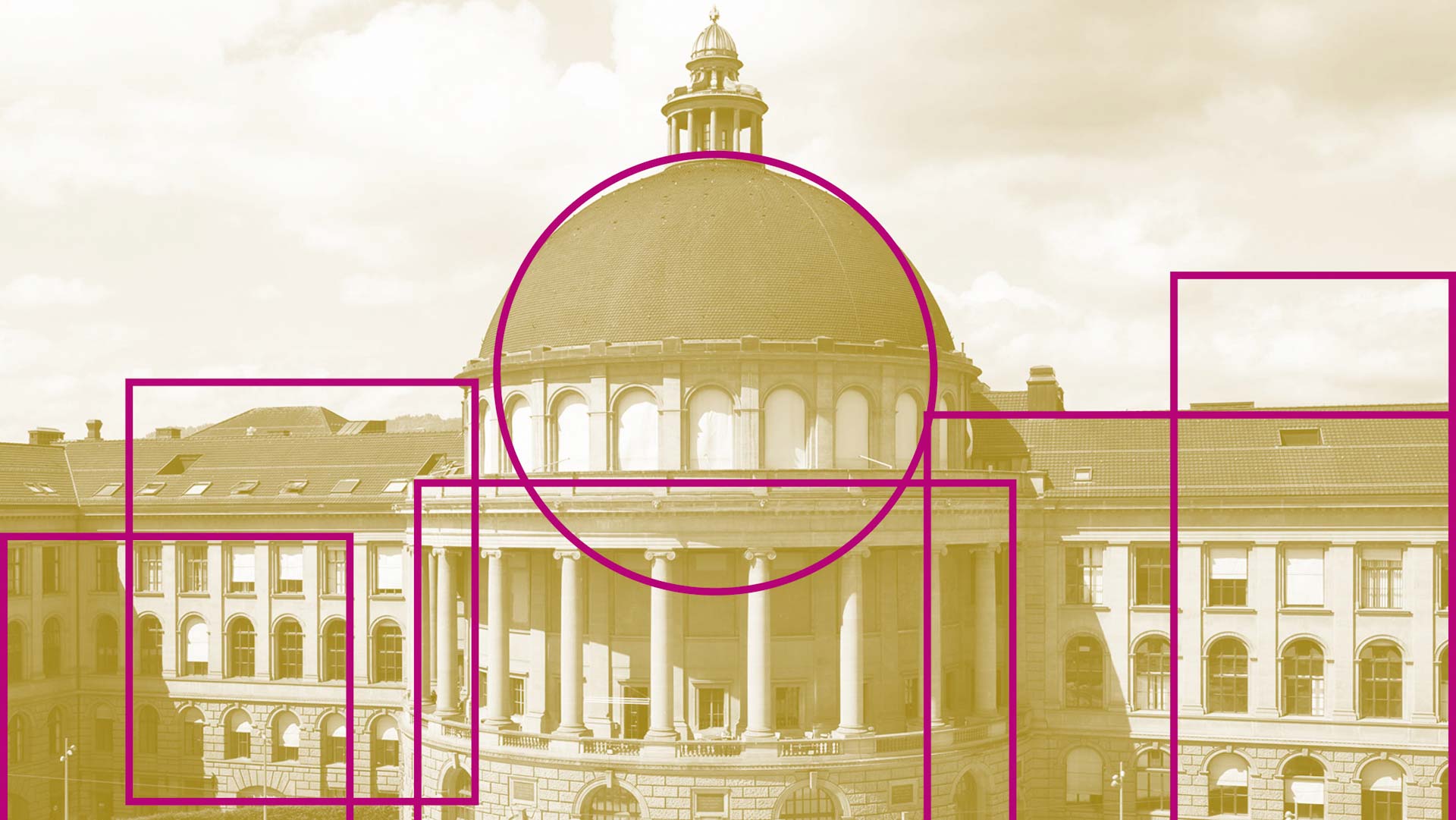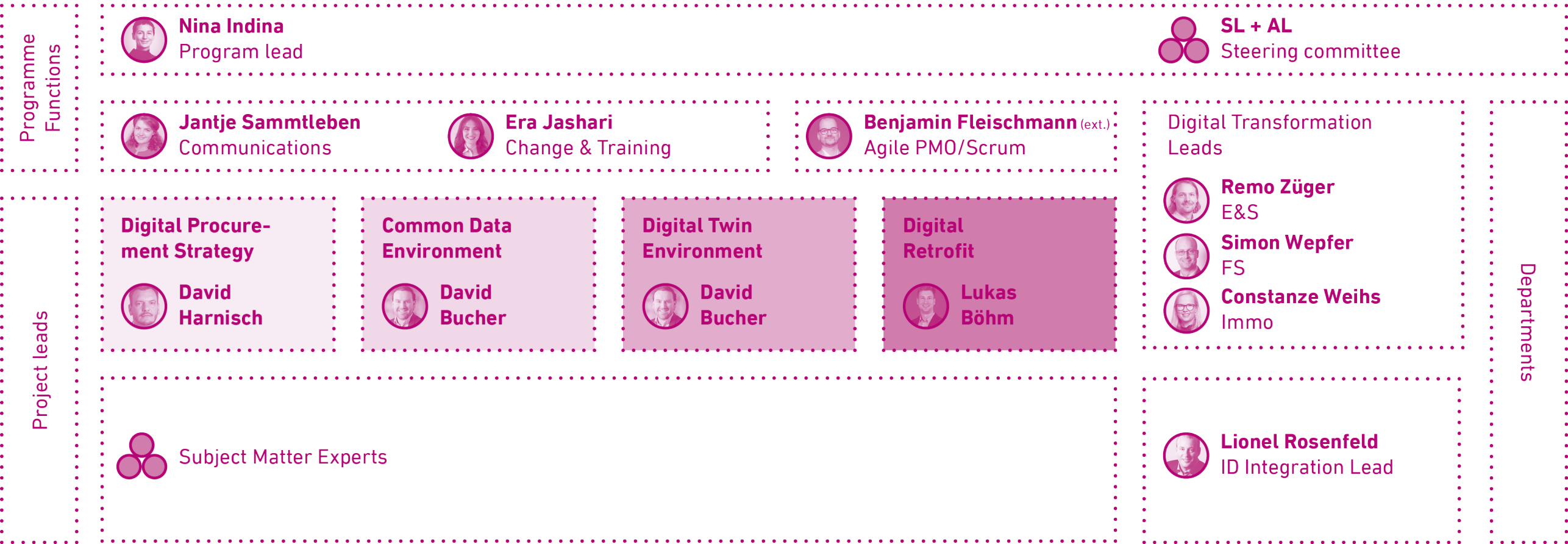Digital Twin – We build bridges to the future
ETH Zurich is developing a digital twin of its campus infrastructure by the end of 2028 – from buildings to technical facilities. The program will create the basis for an efficient use of resources and sustainable campus development through a connected, data-driven organisation.

In a rapidly changing world, ETH Zurich is also facing the challenge of fundamentally rethinking the way it works and uses data. The introduction of the Digital Twin of the ETH infrastructure is a decisive step towards becoming a data-driven organisation and achieving future-oriented, resource-conscious campus development.
The vision of the digital twin of ETH Zurich
The “Digital Twin” program is a large-scale infrastructure project. The aim is to further develop the ETH campus by creating a digital twin of the entire ETH building and facilities portfolio, including existing and new buildings and their infrastructure.
The Digital Twin lays the foundation for a future-proof campus: it provides continuous access to data to enable fast and informed decision-making, and promotes sustainability and efficiency by making it possible to measure and control the use of resources.
The success of the Digital Twin will lie in the combination of technology and organisational transformation. A central goal of the program is to create a deep understanding of the value of accurate and up-to-date data throughout the organisation. In addition to a robust IT architecture, a data culture is therefore needed in which precise and up-to-date information is recognised as a valuable resource. A structured training program that is tailored to the target group will form the basis for the successful use of the digital twin.
The program is extremely ambitious and will take several years to implement, with challenges that cannot yet be foreseen. It requires openness, the willingness to think about processes in a holistic and new way, the determination to endure uncertainties and to continue on the path anyway. Mutual empowerment and the interaction of disciplines across departments are essential to make the ETH campus fit for the future.
The vision of the digital twin calls for a holistic approach that aims to connect the individual areas. We can only realise this vision if different areas of expertise are looking in the same direction. Today, we are embarking on a path that will be of crucial importance for tomorrow. With the digital twin, we are building more than just bridges between areas.
We build bridges to the future.
Program implementation in four projects
Four projects are working closely together to ensure the success of ETH Zurich's Digital Twin program.
Each project addresses a central aspect of a building's entire life cycle. Together, they cover all phases – from planning, construction and commissioning to operation and possible repurposing. The goal is to provide suitable processes, data requirements and digital tools for each phase to enable data-based, resource-efficient management and continuous development.

The aim is to carry out new construction projects in a data-driven and digitised manner. To this end, the ordering bases, competencies and quality assurance processes are to be structured in such a way that plans and other property information can be requested digitally (order), checked (quality assurance) and handed over to the operating unit in an orderly manner after completion of the project.
The project focuses on strengthening procurement competence in the area of BIM and on developing a cross-departmental data quality assurance process that is then embedded in the entire VPIN organisation. The project will support project managers in applying the new standards and will accompany ongoing BIM pilot projects – such as the new HPQ building – to ensure that experience and best practices are secured in the long term. In the future, digital purchaser expertise will form the basis for reliable and high-quality data from all construction projects.
This project establishes the increased use of a Common Data Environment (CDE) as a central collaboration platform for the construction projects of ETH Zurich. The aim is to create clear and efficient communication processes to strengthen data quality, information flow and digital project management with the contractors.
The CDE enables centralised data exchange and provision for all relevant departments and is to be introduced as a standard solution for the internal processing of all ETH construction projects. A partially automated data check ensures quality and traceability, while structured communication channels improve collaboration with the contractors.
Once a construction project is completed, the relevant data is transferred to the operating system and made available in the Digital Twin Environment (DTE) so that it can be reused seamlessly.
The aim of the Digital Twin Environment (DTE) project is to make it easier to access infrastructure data at ETH Zurich by breaking down data silos and creating a basis for data-driven decision-making. In the future, various teams and interest groups should be able to access the data relevant to them quickly and directly.
Scalable data processing and user-friendly analysis tools allow employees – regardless of their technical background – to easily use, evaluate and distribute data in a targeted manner. In order to promote a data-driven approach, employees responsible for data are given targeted training in modern data management practices.
A central element is a common understanding of the value of data and clearly defined responsibilities for its management and maintenance. If data needs to be adapted, this is done with the support of the system and in a comprehensible manner in order to increase data quality and transparency. Regular data quality audits also ensure that reliable and up-to-date information is always available.
The flexible and secure system architecture ensures that data can be optimally integrated and also used with artificial intelligence (AI).
The aim of this project is to digitise the building stock, technical facilities and campus infrastructure of ETH Zurich and to create an accurate, model-based representation of the physical environment. From 2025, the Hönggerberg campus will be the focus of the first phase.
The successful implementation of this project requires close cooperation between the VPIN departments to take into account future campus development projects and to coordinate the timing of the inventory.
During the inventory, state-of-the-art digitisation technologies, open-source and machine-learning approaches will also be tested. This innovative environment offers exciting opportunities for professionals to apply their scripting and programming skills in a practical way.
By digitising the Hönggerberg campus, this project lays the foundation for more precise planning and more efficient maintenance.
Together, the four projects form the basis for a modern and fully data-driven campus infrastructure. They enable precise data management, seamless collaboration and the digital enhancement of existing facilities, thus creating the basis for an innovative and sustainable future at ETH Zurich.
How do we develop the digital twin?
To ensure a successful implementation, the program relies on close, cross-departmental cooperation within the Vice-Presidency for Infrastructure and Sustainability (VPIN) at ETH Zurich. The foundations for future ways of working are being developed in four interdisciplinary projects. In dialogue with experts from the VPIN departments, new processes, data and system requirements, and the resulting communication and training needs are derived. In addition, the program is continuously supported by experts in the fields of communication and change management.

How long does the program need to develop the digital twin?
The program aims to create a future-proof, highly integrated and scalable architecture by the end of 2028, and to establish a data-based work culture that meets the long-term requirements of sustainable campus development at ETH Zurich.
To this end, a first beta version of the Digital Twin is to be tested in 2027, so that the Digital Twin can be transferred into operational use by the end of 2028.
The milestones from 2025 to 2028 provide an orientation. The level of detail in the later phases remains very low to allow flexibility for necessary adjustments.

Benefit of the Digital Twin for the entire ETH
- Economic efficiency: A digital twin increases efficiency in operation and maintenance, enables data-driven decisions and reduces uncertainties in the evaluation of development projects.
- Sustainability: The digital twin supports the sustainability goals of ETH Zurich in the infrastructure domain. It provides access to data on existing materials for the circular economy and, together with energy and building data, leads to a more sustainable use of resources.
- Teaching, research, transfer: The digital twin will create the basis for the sustainable and future-proof development of the campus infrastructure, enabling faster and more precise conversions and adjustments while ensuring safe and reliable operations. In addition, it opens up groundbreaking potential for living lab projects – both on campus and in virtual environments.
- Security and availability: Precise analyses improve planning reliability, reduce risks and ensure stable campus operations.
- Digital transformation: The program accelerates the digital transformation in the ETH administration and the development of digital skills. In addition, the “Digital Twin” program promotes close cooperation between the administrative units.
- Outreach: ETH Zurich will be one of the few universities worldwide to have a campus-wide digital twin of its infrastructure. This makes ETH a pioneering role model setting standards for innovation and excellence in this area.
Contact Program Lead
Abt. Engineering & Systeme
OCT H 19
8092
Zürich